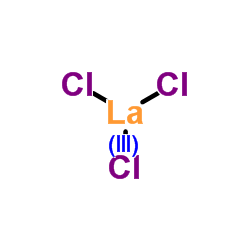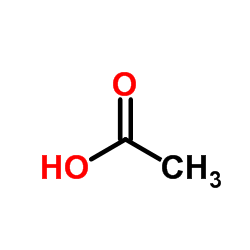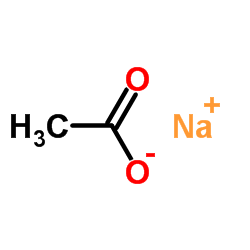917-70-4
| 中文名 | 醋酸镧 |
|---|---|
| 英文名 | Acetic acid,lanthanum(3+) salt (3:1) |
| 中文别名 |
乙酸鑭
乙酸镧(1.5水) |
| 英文别名 |
lanthanum(II) acetate
LANTHANUM ACETATE lanthanum(3+) acetate MFCD00013037 lanthanacetat lanthane(III) acetate anhydrous lanthanum acetate LANTHANUM (III) ACETATE acetic acid,lanthanum (III)-acetate lanthanum(3+) triethanoate EINECS 213-034-8 LANTHANUMACETATE,HIGHPURITY Acetic acid,lanthanumsalt lanthanumtriacetate lanthanum(3+) triacetate |
| 密度 | 1.64 |
|---|---|
| 沸点 | 117.1ºC at 760 mmHg |
| 熔点 | 110ºC |
| 分子式 | C2H4LaO2 |
| 分子量 | 198.95700 |
| 精确质量 | 198.92700 |
| PSA | 37.30000 |
| LogP | 0.09090 |
| 外观性状 | 白色固体 |
| 储存条件 | 室温 |
| 稳定性 | 溶于水,18℃时,100mL水中可溶解无水物20.43g。溶于苯。加热至760℃,分解为氧化镧。一水或1.5水合物均为无色或白色晶体,溶于水。La(CH3COO)3·DMF易溶于水,不溶于乙醚,难溶或不溶于冷DMF中,慢慢冷却得到大结晶。加热至210℃失去DMF。 |
| 水溶解性 | 每100毫升水中的溶解克数: 16.9g/20℃ |
| 计算化学 | 1.疏水参数计算参考值(XlogP):无 2.氢键供体数量:0 3.氢键受体数量:6 4.可旋转化学键数量:0 5.互变异构体数量:无 6.拓扑分子极性表面积120 7.重原子数量:13 8.表面电荷:0 9.复杂度:25.5 10.同位素原子数量:0 11.确定原子立构中心数量:0 12.不确定原子立构中心数量:0 13.确定化学键立构中心数量:0 14.不确定化学键立构中心数量:0 15.共价键单元数量:4 |
| 更多 | 一、物性数据 1. 性状:无色或白色结晶,具吸湿性。 2. 密度(g/mL,25/4℃):不确定 3. 相对蒸汽密度(g/mL,空气=1):不确定 4. 熔点(ºC):不确定 5. 沸点(ºC,常压):不确定 6. 沸点(ºC,5.2kPa):不确定 7. 折射率:不确定 8. 闪点(ºC):不确定 9. 比旋光度(ºC):不确定 10. 自燃点或引燃温度(ºC)不确定 11. 蒸气压(kPa,25ºC):不确定 12. 饱和蒸气压(kPa,60ºC):不确定 13. 燃烧热(KJ/mol):不确定 14. 临界温度(ºC):不确定 15. 临界压力(KPa):不确定 16. 油水(辛醇/水)分配系数的对数值:不确定 17. 爆炸上限(%,V/V):不确定 18. 爆炸下限(%,V/V):不确定 19. 溶解性:溶于水。 |
|
Section 1. Chemical Product and Company Identification Lanthanum acetateCatalog Common Name/ Number(s). Trade Name CAS#917-70-4 Manufacturer
RTECSAI5075000 SPECTRUM CHEMICAL MFG. CORP. TSCATSCA 8(b) inventory: Lanthanum acetate Commercial Name(s)Not available. CI# Not available. SynonymNot available. IN CASE OF EMERGENCY Not available. Chemical Name Chemical FamilyNot available.CALL (310) 516-8000 La(OOCCH3)3.1-1/2H20 Chemical Formula SPECTRUM CHEMICAL MFG. CORP. Section 2.Composition and Information on Ingredients Exposure Limits TWA (mg/m3)STEL (mg/m3) CEIL (mg/m3) NameCAS #% by Weight 1) Lanthanum acetate917-70-4100 Toxicological DataLanthanum acetate: on IngredientsORAL (LD50):Acute: 10000 mg/kg [Rat]. Section 3. Hazards Identification Potential Acute Health Effects Hazardous in case of skin contact (irritant), of eye contact (irritant), of ingestion, of inhalation. Potential Chronic HealthCARCINOGENIC EFFECTS: Not available. MUTAGENIC EFFECTS: Not available. Effects TERATOGENIC EFFECTS: Not available. DEVELOPMENTAL TOXICITY: Not available. Repeated or prolonged exposure is not known to aggravate medical condition. Lanthanum acetate Section 4. First Aid Measures Eye ContactCheck for and remove any contact lenses. Do not use an eye ointment. Seek medical attention. Skin ContactAfter contact with skin, wash immediately with plenty of water. Gently and thoroughly wash the contaminated skin with running water and non-abrasive soap. Be particularly careful to clean folds, crevices, creases and groin. Cover the irritated skin with an emollient. If irritation persists, seek medical attention. Wash contaminated clothing before reusing. Serious Skin ContactWash with a disinfectant soap and cover the contaminated skin with an anti-bacterial cream. Seek medical attention. InhalationAllow the victim to rest in a well ventilated area. Seek immediate medical attention. Serious InhalationNot available. IngestionDo not induce vomiting. Loosen tight clothing such as a collar, tie, belt or waistband. If the victim is not breathing, perform mouth-to-mouth resuscitation. Seek immediate medical attention. Serious IngestionNot available. Section 5. Fire and Explosion Data Flammability of the Product May be combustible at high temperature. Auto-Ignition Temperature Not available. Flash PointsNot available. Flammable LimitsNot available. These products are carbon oxides (CO, CO2). Products of Combustion Fire Hazards in Presence of Not available. Various Substances Explosion Hazards in Presence Risks of explosion of the product in presence of mechanical impact: Not available. of Various SubstancesRisks of explosion of the product in presence of static discharge: Not available. Fire Fighting MediaSMALL FIRE: Use DRY chemical powder. and InstructionsLARGE FIRE: Use water spray, fog or foam. Do not use water jet. Special Remarks onNot available. Fire Hazards Special Remarks on Explosion Not available. Hazards Section 6. Accidental Release Measures Small SpillUse appropriate tools to put the spilled solid in a convenient waste disposal container. Finish cleaning by spreading water on the contaminated surface and dispose of according to local and regional authority requirements. Large Spill Use a shovel to put the material into a convenient waste disposal container. Finish cleaning by spreading water on the contaminated surface and allow to evacuate through the sanitary system. Lanthanum acetate Section 7. Handling and Storage PrecautionsKeep away from heat. Keep away from sources of ignition. Empty containers pose a fire risk, evaporate the residue under a fume hood. Ground all equipment containing material. Do not ingest. Do not breathe dust. Wear suitable protective clothing In case of insufficient ventilation, wear suitable respiratory equipment If ingested, seek medical advice immediately and show the container or the label. Avoid contact with skin and eyes StorageKeep container dry. Keep in a cool place. Ground all equipment containing material. Keep container tightly closed. Keep in a cool, well-ventilated place. Combustible materials should be stored away from extreme heat and away from strong oxidizing agents. Section 8. Exposure Controls/Personal Protection Engineering ControlsUse process enclosures, local exhaust ventilation, or other engineering controls to keep airborne levels below recommended exposure limits. If user operations generate dust, fume or mist, use ventilation to keep exposure to airborne contaminants below the exposure limit. Personal ProtectionSplash goggles. Lab coat. Dust respirator. Be sure to use an approved/certified respirator or equivalent. Gloves. Personal Protection in Case of Splash goggles. Full suit. Dust respirator. Boots. Gloves. A self contained breathing apparatus should be used a Large Spillto avoid inhalation of the product. Suggested protective clothing might not be sufficient; consult a specialist BEFORE handling this product. Exposure LimitsNot available. Section 9. Physical and Chemical Properties Physical state and appearance Solid.OdorNot available. TasteNot available. 343.07 g/mole Molecular Weight ColorNot available. pH (1% soln/water)Not available. Boiling PointNot available. Melting PointDecomposes. Critical TemperatureNot available. Specific GravityNot available. Not applicable. Vapor Pressure Vapor DensityNot available. VolatilityNot available. Odor ThresholdNot available. Water/Oil Dist. Coeff.Not available. Not available. Ionicity (in Water) Dispersion PropertiesNot available. Not available. Solubility Section 10. Stability and Reactivity Data The product is stable. Stability Instability TemperatureNot available. Not available. Conditions of Instability Incompatibility with various Not available. substances Lanthanum acetate CorrosivityNon-corrosive in presence of glass. Special Remarks onNot available. Reactivity Special Remarks onNot available. Corrosivity PolymerizationNo. Section 11. Toxicological Information Routes of EntryEye contact. Inhalation. Ingestion. Toxicity to AnimalsAcute oral toxicity (LD50): 10000 mg/kg [Rat]. Chronic Effects on Humans Not available. Other Toxic Effects onHazardous in case of skin contact (irritant), of ingestion, of inhalation. Humans Special Remarks onNot available. Toxicity to Animals Special Remarks onNot available. Chronic Effects on Humans Special Remarks on otherNot available. Toxic Effects on Humans Section 12. Ecological Information EcotoxicityNot available. BOD5 and CODNot available. Products of BiodegradationPossibly hazardous short term degradation products are not likely. However, long term degradation products may arise. Toxicity of the ProductsThe products of degradation are more toxic. of Biodegradation Special Remarks on theNot available. Products of Biodegradation Section 13. Disposal Considerations Waste Disposal Section 14. Transport Information DOT ClassificationNot a DOT controlled material (United States). IdentificationNot applicable. Special Provisions forNot applicable. Transport Lanthanum acetate DOT (Pictograms) Section 15. Other Regulatory Information and Pictograms TSCA 8(b) inventory: Lanthanum acetate Federal and State Regulations California Proposition 65 Warnings Other RegulationsNot available.. WHMIS (Canada) Not controlled under WHMIS (Canada). Other Classifications DSCL (EEC)R36/38- Irritating to eyes and skin. Health Hazard HMIS (U.S.A.)2 National Fire Protection 1 Flammability 1 Association (U.S.A.) Fire Hazard 2 0 Reactivity Health Reactivity 0 Specific hazard Personal Protection E WHMIS (Canada) (Pictograms) DSCL (Europe) (Pictograms) TDG (Canada) (Pictograms) ADR (Europe) (Pictograms) Protective Equipment Gloves. Lab coat. Dust respirator. Be sure to use an approved/certified respirator or equivalent. Lanthanum acetate SECTION 16 - ADDITIONAL INFORMATION N/A |
|
毒理学数据: 急性数据:大鼠经口LD50:10 gm/kg; 大鼠腹腔LD50:475 mg/kg; 小鼠皮下LD50:3500 mg/kg; 致突变数据 DNA测试:大肠杆菌100 umol/L CHEMICAL IDENTIFICATION
HEALTH HAZARD DATAACUTE TOXICITY DATA
MUTATION DATA
|
| 危害码 (欧洲) | C |
|---|
|
~% 
917-70-4 |
| 文献:Journal of Inorganic and Nuclear Chemistry, , vol. 25, p. 201 - 203 |
|
~% 
917-70-4 |
| 文献:Journal of Molecular Structure, , vol. 563-564, p. 587 - 593 |
|
~% 
917-70-4 |
| 文献:Egypt. J. Chem., , vol. 26, p. 125 - 132 Sc: MVol.D4, 1.4.10, page 52 - 53 |
| 上游产品 3 | |
|---|---|
| 下游产品 0 | |




